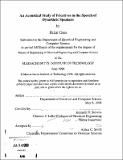| dc.contributor.advisor | Kenneth N. Stevens. | en_US |
| dc.contributor.author | Chen, Helen (Haiying Helen), 1975- | en_US |
| dc.contributor.other | Massachusetts Institute of Technology. Dept. of Electrical Engineering and Computer Science. | en_US |
| dc.date.accessioned | 2009-11-06T16:37:26Z | |
| dc.date.available | 2009-11-06T16:37:26Z | |
| dc.date.copyright | 1998 | en_US |
| dc.date.issued | 1998 | en_US |
| dc.identifier.uri | http://hdl.handle.net/1721.1/49801 | |
| dc.description | Thesis (M.Eng.)--Massachusetts Institute of Technology, Dept. of Electrical Engineering and Computer Science, 1998. | en_US |
| dc.description | Includes bibliographical references (leaves 55-57). | en_US |
| dc.description.abstract | The goal of the present study is to better understand dysarthric speakers' speech production through quantitative acoustical analysis of the speech signals. In the past, two acoustical measurements proven to correlate with speech intelligibility in dysarthric speakers are speech rate and slope of the F2 frequency change for certain consonant vowel syllables. In this thesis, several new spectral parameters from acoustical analysis that reflect neuro motor dysfunctions in production of the fricative /s/ have been devised and are presented. These parameters specify the spectrum shape and relative amplitude of the fricative noise, the presence or absence of voicing, and the time variation of the spectrum preceding, during, and following the fricative. Analysis shows that these parameters are highly correlated with the speakers' overall intelligibility as well as intelligibility of the fricative /s/. The top three parameters that differentiate the intelligibility of speakers are related to the spectral shape (spectral tilt), the amount of variation in spectral energy (time variation within the fricative), and the amount of inadvertent spectral energy present prior to frication (precursor). The long-term aim of the study is to develop methods for quantifying disordered speech and for determining the deviation from normal speech. In the long run, these methods can be used to objectively measure the effectiveness of speech therapy as well as the amount of speech degeneration in dysarthric speakers. | en_US |
| dc.description.statementofresponsibility | by Helen Chen. | en_US |
| dc.format.extent | 62 leaves | en_US |
| dc.language.iso | eng | en_US |
| dc.publisher | Massachusetts Institute of Technology | en_US |
| dc.rights | M.I.T. theses are protected by
copyright. They may be viewed from this source for any purpose, but
reproduction or distribution in any format is prohibited without written
permission. See provided URL for inquiries about permission. | en_US |
| dc.rights.uri | http://dspace.mit.edu/handle/1721.1/7582 | en_US |
| dc.subject | Electrical Engineering and Computer Science. | en_US |
| dc.title | An acoustical study of fricatives in the speech of dysarthric speakers | en_US |
| dc.type | Thesis | en_US |
| dc.description.degree | M.Eng. | en_US |
| dc.contributor.department | Massachusetts Institute of Technology. Department of Electrical Engineering and Computer Science | |
| dc.identifier.oclc | 50616551 | en_US |
